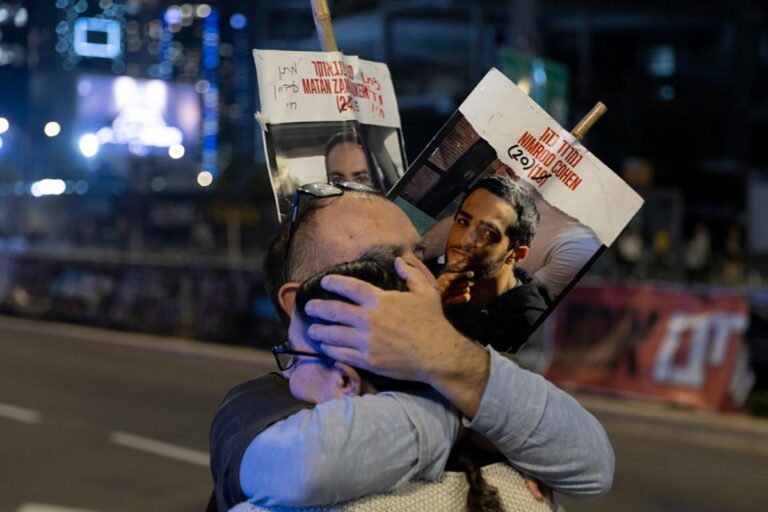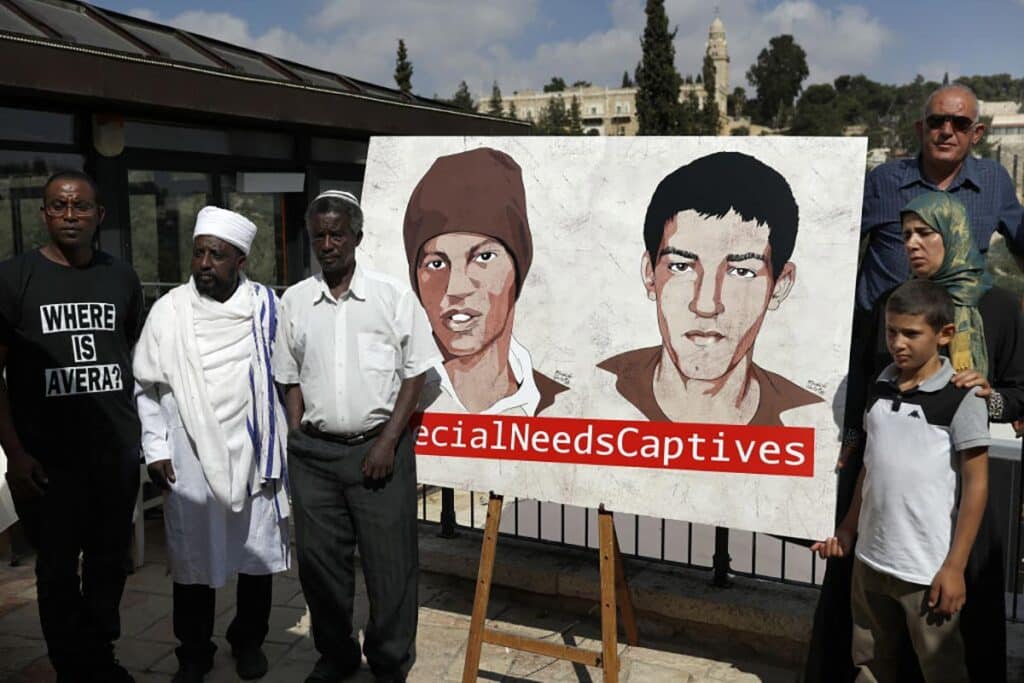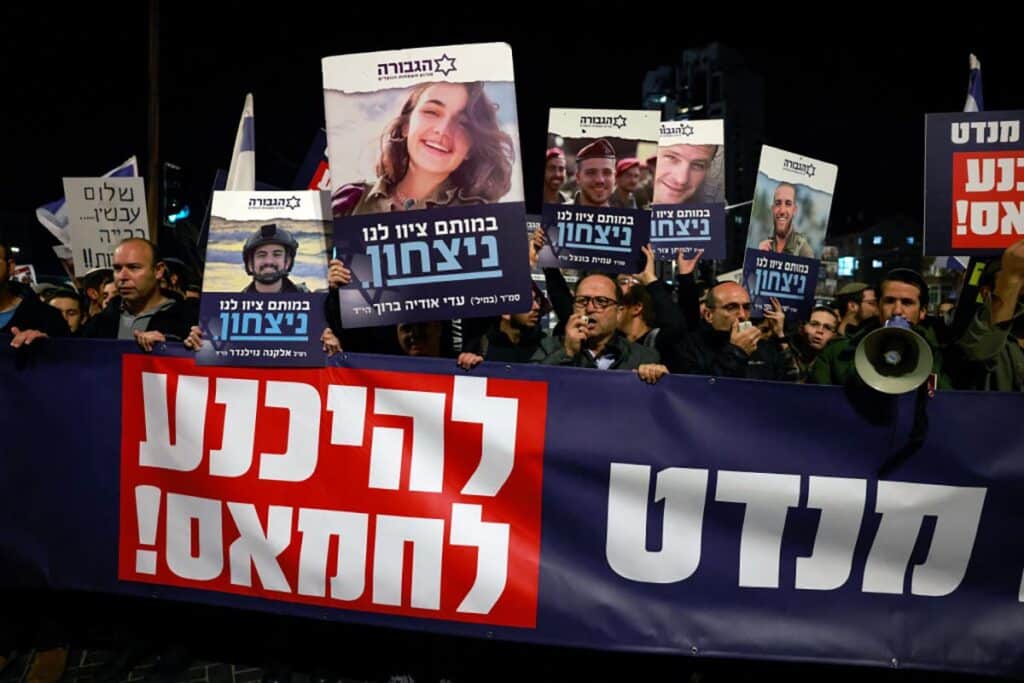
After 15 months of war, Israel and Hamas agreed to a hostage and ceasefire deal on Wednesday evening, securing the release of 33 hostages during a six-week ceasefire.
The ceasefire is set to begin on Sunday at 12:15 p.m.
Hamas is believed to be holding 98 hostages, including four Israelis who were kidnapped in 2014. It is unclear how many of the hostages are alive, although Israeli officials have confirmed that at least 30 are dead.
Two hundred and fifty people were taken captive by Hamas on Oct. 7, 2023. In Nov. 2023, 105 were released in a ceasefire deal and eight were rescued by the IDF in missions since the war began.
The agreement faced several roadblocks in the final hours of the negotiations, with Hamas submitting last-minute demands concerning the areas that Israel would withdraw from.
While some of the details of the agreement are still unclear, here’s what we know so far:
How will the ceasefire work?
First phase:
Thirty-three hostages are set to be released in the first phase, which will last at least six weeks.
Three or four hostages will be released each subsequent week of the ceasefire, except for in the final week when 14 hostages will be released.
During this phase, Hamas will return hostages categorized as “humanitarian cases,” including women (including female soldiers), men over 50, and any sick or wounded hostages.
Avera Mengistu and Hisham al-Sayed, two Israelis kidnapped by Hamas in 2014 and 2015, respectively, will also be released in the last week of the first phase.

Meanwhile, about 1,300 Palestinian terrorists will be released from Israeli prisons, including about 250 with life sentences. One thousand of the prisoners set to be exchanged were arrested after the Oct. 7 attacks, according to Palestinian reports.
Talks are continuing on Wednesday night to finalize the Palestinian prisoners who will be released. The list will be published online once the Israeli government officially approves the deal so that Israelis can file legal appeals to the release of specific terrorists.
About 100 of the Palestinian prisoners set to be released in the first phase will be exiled outside of Gaza and the West Bank, a Hamas source told Palestinian media. Terrorists from Hamas’ Nukhba Unit, which was central in the Oct. 7 attacks, will not be released in the deal.
Throughout the ceasefire, the IDF will withdraw from residential areas in Gaza, as well as from the Netzarim Corridor, a road set up by the IDF that crosses the middle of the Gaza Strip.
Palestinians will also be allowed to return to northern Gaza, seemingly without any significant restrictions. About 600 trucks of humanitarian aid will enter Gaza daily during the ceasefire, half of which will go to northern Gaza.
The Rafah Crossing will be opened seven days after the ceasefire is announced.
On the 16th day of the initial phase, negotiations will begin concerning the second phase of the deal, which would bring about an end to the war.
At the end of this phase, the IDF will withdraw from the Philadelphi Corridor, the strip of land along the Gaza-Egypt border.
In a press conference Wednesday evening, U.S. President Joe Biden stressed that the first phase of the ceasefire would continue as long as negotiations concerning the second and third phases continue.
Second phase:
The remaining living hostages will be released in this stage, and Israel will release hundreds more Palestinian prisoners. The IDF will complete its withdrawal from Gaza, and the war will come to a complete end.
Third phase:
The remains of dead hostages will be returned to Israel, and the reconstruction of Gaza will begin.
Will Hamas be removed from power?
One major issue is missing from the ceasefire agreement: the Israeli demand to end Hamas’s rule of Gaza.
While some Israeli officials have pushed for a renewal of the war after the first phase of the ceasefire to achieve that goal, some world leaders have pushed for Israel to achieve this through diplomatic measures.

On Tuesday, U.S. Secretary of State Antony Blinken laid out some of the elements of a plan for the “day after” the war aimed at preventing Hamas from remaining in control of Gaza.
The plan would have the Palestinian Authority work with international partners to run an interim administration in charge of civil matters in Gaza, such as banking, water, energy, and health. The interim administration would include PA representatives and Palestinians from Gaza.
Meanwhile, an interim security mission made up of unspecified “partner nation security forces” and “vetted Palestinian personnel” would be established to secure humanitarian and reconstruction efforts and ensure border security.
How did we get here?
This deal is largely similar to a proposed agreement pushed by the U.S. back in May.
Israel and Hamas have traded blame for why the deal wasn’t reached earlier.
Government Secretary Yossi Fox affirmed on Tuesday that the deal signed was the same as the one proposed in May, adding that Hamas had rejected the deal for the past six months.
National Security Minister Itamar Ben-Gvir claimed that he was responsible for the fact that a deal wasn’t reached earlier. The minister complained that “additional elements” had been added to the government who now supported the deal, in a seeming reference to MK Gideon Sa’ar who joined the government in September.
An Israeli source rejected Ben-Gvir’s claims in a statement to Israeli media, affirming that Hamas was the sole reason that a deal wasn’t reached earlier.
The source claimed that Hamas had bent on its demands due to Israel’s achievements in the war, as well as political pressure exerted on Hamas by U.S. president-elect Donald Trump. He added that Hamas refused to release more than 12 hostages and rejected any deal that allowed Israel to remain in Gaza at all.

Pressure from the incoming Trump administration reportedly wasn’t placed solely on Hamas.
Trump’s Middle East envoy Steve Witkoff reportedly held a “tense” meeting with Netanyahu over the weekend, pushing the prime minister to accept the compromises needed in order to reach a deal.
The U.S., Qatar, and Egypt reportedly have provided guarantees that they will ensure this deal ends the war.
Qatari Prime Minister Mohammed bin Abdulrahman bin Jassim Al Thani stressed that Qatar, Egypt, and the U.S. will monitor the implementation of the ceasefire.
Hostage families welcome deal amid anxiety about future
The Hostages and Missing Families Forum welcomed the agreement, calling it “important and significant progress that brings us closer to the moment when we will see all the hostages return – the living for rehabilitation in the embrace of their families and the dead for a proper burial in their homeland.”
The Forum warned, however, that “the trek has only just begun and will not end until the last hostage returns.”
“The Israeli government, its leader, and all involved parties must ensure the full implementation of the agreement down to the last hostage,” stressed the Forum. “We demand that the safety and health of the hostages who remain in Hamas captivity be guaranteed until their release on a clear and specific date and all stages of the deal are fulfilled. The announcement of the signing does not allow for joy or relief among the families. Our breath will remain held until all our loved ones return home.”
After staying silent for most of the day, Prime Minister Benjamin Netanyahu issued a statement thanking Trump for his help in achieving the deal and “made it clear that he is committed to returning all the hostages by any means.” Netanyahu added that he would meet with Trump soon in Washington.
The prime minister also spoke with Biden and thanked him as well.
As of Wednesday night, Netanyahu had not made any other statement to the Israeli public concerning the agreement, sparking some confusion in Israel. Earlier in the day, the Prime Minister’s Office had said that Netanyahu would issue a statement once the deal was finalized.
In a speech on Wednesday evening, Israeli President Isaac Herzog expressed regret that the state had “failed to fulfill its duty and to fulfill the most basic alliance between a state and its citizens” on Oct. 7th, describing the ceasefire as a “correction” of that failure.
“This is the right, important, and necessary move. There is no greater Jewish and Israeli moral and human obligation than to bring home our brothers and sisters, some for rehabilitation and some to be laid to rest,” said Herzog on Wednesday.
The president noted, “There are no illusions here. This deal – when approved and implemented – will bring with it difficult, agonizing, and extremely moving moments. It will also bring with it extremely difficult challenges. It is clear to all of us that we will have to use the entire security and political toolbox and stand firmly for our security interests – which will protect all of Israel’s residents.”
Herzog also called for the Israeli public to show “immense sensitivity” toward the families of then hostages. “I would like to especially embrace the anxious and sorrowful families, who fear that their loved ones will not return in the first phase of the deal,” said the president.
Right-wing ministers warn deal is ‘surrender’ to Hamas
Ben-Gvir and Finance Minister Bezalel Smotrich expressed opposition to the deal, warning it was a “surrender” to Hamas.
Smotrich called the deal “a bad and dangerous deal for the national security of the State of Israel.”
The finance minister announced that he had given Netanyahu an ultimatum, warning that if Israel did not resume the war with even greater strength after the first phase of the deal, he would resign from the government.
Smotrich reportedly additionally demanded that Netanyahu fire IDF Chief of Staff Herzi Halevi and other top commanders in the army.
Ben-Gvir warned that the deal “effectively erases the war achievements that have been achieved with much blood by our fighters, so far, in the Gaza Strip.” He also expressed concerns that the deal would not result in the release of all the hostages.
The minister added that the release of hundreds of Palestinian terrorists would put Israelis’ lives at risk.
“This is not a ‘hard choice’ that must be made to return the hostages. It is a conscious choice at the cost of the lives of many other Israeli citizens, who, unfortunately, will pay the price of this deal with their lives,” Ben-Gvir insisted. “We have already seen the fruits of these deals in the past. We learned the hard way that there is no cover for all the promises that ‘we will deal with it later.'”
If Smotrich and Ben-Gvir’s parties both leave the government, it will be left without a majority in the Knesset. That could put the coalition at risk of collapse and spark early elections, as without a majority, most governments can’t function effectively.

The Gvura and Tikva Forums, which represent some of the families of hostages and fallen soldiers, expressed staunch opposition to the deal as well, warning that it would lead to the abandonment of many hostages and seriously harm Israel’s national security.
The families had demanded that any deal release all of the hostages in one phase.
Zvika Mor, the father of hostage Eitan Mor, compared the deal to the agreement in which IDF soldier Gilad Shalit was released from Hamas captivity in 2011. Hamas leader Yahya Sinwar, the mastermind behind the Oct. 7 attacks, was released in that deal.
“I call out to the prime minister from here. After the terrible mistake you made in the Shalit deal, for which I am paying the price today along with many citizens of the State of Israel, how can you lend your hand to a reckless deal that abandons the young men and soldiers, including my son Eitan, and seals the fate of who knows how many Jews, God forbid,” said Mor.
World leaders welcome deal
Even before the agreement was officially announced, Trump posted on Truth Social “WE HAVE A DEAL FOR THE HOSTAGES IN THE MIDDLE EAST. THEY WILL BE RELEASED SHORTLY. THANK YOU!”
“This EPIC ceasefire agreement could have only happened as a result of our Historic Victory in November, as it signaled to the entire World that my Administration would seek Peace and negotiate deals to ensure the safety of all Americans, and our Allies,” added Trump. “I am thrilled American and Israeli hostages will be returning home to be reunited with their families and loved ones.”
The president-elect added that he would continue to work closely with Israel and U.S. allies “to make sure Gaza NEVER again becomes a terrorist safe haven.”
“We will continue promoting PEACE THROUGH STRENGTH throughout the region, as we build upon the momentum of this ceasefire to further expand the Historic Abraham Accords. This is only the beginning of great things to come for America, and indeed, the World!” added Trump.
Biden welcomed the deal as well, saying, “This deal will halt the fighting in Gaza, surge much needed-humanitarian assistance to Palestinian civilians, and reunite the hostages with their families after more than 15 months in captivity.”
“I laid out the precise contours of this plan on May 31, 2024, after which it was endorsed unanimously by the UN Security Council,” Biden said. “It is the result not only of the extreme pressure that Hamas has been under and the changed regional equation after a ceasefire in Lebanon and weakening of Iran — but also of dogged and painstaking American diplomacy. My diplomacy never ceased in their efforts to get this done.”
“Even as we welcome this news, we remember all the families whose loved ones were killed in Hamas’s October 7th attack, and the many innocent people killed in the war that followed. It is long past time for the fighting to end and the work of building peace and security to begin,” added the president.
Egyptian President Abdel Fattah El-Sisi welcomed the ceasefire agreement, saying, “I stress the importance of accelerating the entry of urgent humanitarian aid to the people of Gaza, to confront the current catastrophic humanitarian situation, without any obstacles, until sustainable peace is achieved through the two-state solution, and for the region to enjoy stability, security, and development in a world that is large enough for everyone.”
